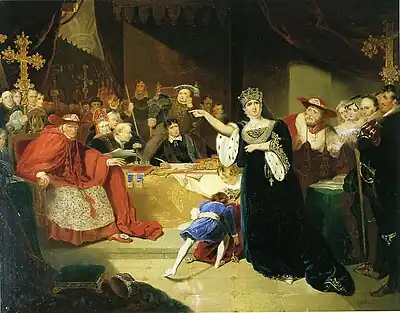| Kemble family | |
|---|---|
| Family | |
| Country | England |

Kemble is the name of a family of English actors, who reigned over the English stage for many decades. The most famous were Sarah Siddons (1755–1831) and her brother John Philip Kemble (1757–1823), the two eldest of the twelve children of Roger Kemble (1721–1802), a strolling player and manager of the Warwickshire Company of Comedians, who in 1753 married an actress, Sarah Ward. Roger Kemble was born in Hereford, and was a grand-nephew of Father John Kemble, a recusant Catholic priest, who was hanged in that city in 1679. Three younger children of Roger, Stephen Kemble (1758–1822), Charles Kemble (1775–1854), and Elizabeth Whitlock (1761–1836), were also actors, while Ann Hatton was a novelist.
Popular culture
In George Henry Harlow's famous painting The Court for the Trial of Queen Katharine he depicted many of the Kemble family members. The subject of the painting comes from Henry VIII, Act II, Scene iv, and the refutation of Cardinal Wolsey, charged with obtaining Henry's divorce from his Queen, Katherine. The production was mounted by John Philip Kemble when he took over the management of Covent Garden in 1806. Harlow was a personal friend of the Kemble family and this picture is homage to his friends. John Philip Kemble clothed in scarlet plays Wolsey; his brother Charles Kemble (in black) has the part of Thomas Cromwell and sits behind the table. Immediately behind and above him is Stephen Kemble as Henry. The sister, Sarah Siddons, is Katherine.[1]
Extended family
The tradition was continued by two daughters of Charles Kemble and Maria Theresa Kemble: actress and Shakespearean reader Fanny Kemble (1800–1893) and Adelaide Kemble (1815–1879), an opera singer. Both Sarah Siddon's son Henry Kemble and Stephen Kemble's son, also named Henry Kemble, became actors.
Among later members of the Kemble family, mention may also be made of Charles Kemble's grandson, Henry Kemble (1848–1907), a sterling and popular London actor, and of Alice Barnett, a great-granddaughter of Stephen Kemble, who performed leading roles as a comic actress and singer in the works of Gilbert and Sullivan.[2][3][4] At least two 20th Century members were Violet Kemble-Cooper and Lillian Kemble-Cooper. The 20th-century Scottish socialite Jane Beadon was also a descendant of the Kemble family.
References
- ↑ Details of the painting are explained by Desmond Shawe-Taylor in Jane Martineau's Shakespeare in Art (148).
- ↑ "Obituary: Miss Alice Barnett", The Advertiser (Adelaide, South Australia), 18 April 1901, p. 5
- ↑ Gänzl, Kurt (2021). Gilbert and Sullivan: The Players and the Plays. Albany, New York: State University of New York Press. pp. 136–139. ISBN 978-1-4384-8545-4.
- ↑ The Genealogists' Magazine, vol. 7, The Society (1935), p. 13
References
- This article incorporates text from a publication now in the public domain: Chisholm, Hugh, ed. (1911). "Kemble". Encyclopædia Britannica (11th ed.). Cambridge University Press.